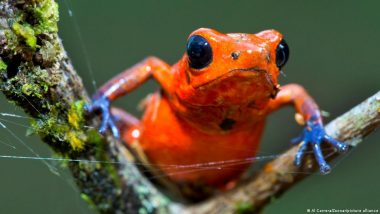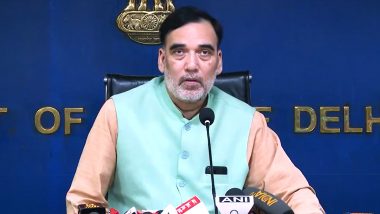Animals, plants, fungi – biodiversity holds a treasure trove of chemicals that can be used to treat diseases from malaria to cancer. But biodiversity loss is driving species to extinction and with it our medicine hopes.Bright reds, yellows and blues – the colour of poison dart frogs offer a stark warning to curious predators: 'eat me and you'll be sorry'. The amphibians are toxic. When eaten, the chemicals on their skin can cause convulsions, muscle contractions and even death.
Also Read | India News | Karnataka: Police Seize Unaccounted Cash in Gadag.
For humans, these colours mean something more hopeful. Those same poisonous chemicals could provide the key to medications that treat infections now resistant to the antibiotics we have already developed.
Also Read | Entertainment News | Priyanka Chopra with Daughter Malti Marie Seek Blessing at Siddhivinayak Temple.
"Poison dart frogs have important medical compounds that are good anaesthetics," said E.J. Milner-Gulland, a professor specializing in biodiversity at Oxford University. "They have good antibiotics that are on their skin that we are using now. And many that haven't even been discovered or commercialized yet."
Basis for much needed medicine
Natural compounds found on frogs, plants and many other species provide the basis for many of our medicines. Paclitaxel, a drug used to treat cancer, for example, is derived from the bark of the Pacific yew tree, and ziconotide, a drug that is used to treat severe pain comes from cone snails. Around 70 percent of cancer medications are based on nature, according to the UN's Intergovernmental Science-Policy Platform on Biodiversity and Ecosystem Services (IPBES).
But biodiversity, which includes the plants, animals, fungi and bacteria found on Earth, are disappearing – and so, too, are the possibilities they hold.
"Climate change, and chytrid fungus have decimated our frog populations and led to a large number of extinctions," Milner-Gulland told DW. Chytrid fungus causes a disease in amphibians that has wiped out as many as 90 species, according to some estimates.
"Maybe we don't need so many different hundreds of species of frog. But on the other hand, that potential kind of treasure trove is still there," she added.
Human-driven extinction
Around one million animal and plant species are currently estimated to be threatened with extinction, according to a 2019 report published by IPBES, although estimates vary wildly according to the source.
Experts say species are disappearing 1,000 to 10,000 times faster than the normal rate of extinction and that humans are to blame.
"The two things that threaten biodiversity the most at the moment are overharvesting and land conversion. That's not just clearance of land for livestock to graze, but also clearance of land for food and clearance of oceans," said Milner-Gulland.
Since 1990, around 420 million hectares of forest – an area almost the size of the European Union – has been lost – turned into farmland and cleared for other uses. Meanwhile, fish stocks are also diminishing, with figures from 2017 estimating that we've overfished a third of global stocks.
Human-driven climate change is also having an impact. Growing carbon dioxide levels are leading to increased ocean acidification, bleaching corals and destroying vast habitats. Rising temperatures and unsustainable harvesting are also pushing some plant species to the edge of extinction.
Traditional medicine
While the loss of biodiversity is making it more difficult to discover new medications, it is also affecting how communities access traditional medicine. An estimated four billion people still rely primarily on natural remedies to heal themselves – whether it's using latex from fig trees to treat intestinal parasites in the Amazon or neem oil to treat skin disorders in India.
"They don't go to the pharmacy, they go to what they've collected and store. So when those plants are difficult to access, that's putting their health at risk," said Cassandra Quave, a medical ethnobotanist at Emory University.
Around 40 percent of the world's plant species are threatened with extinction, according to a report published by the Royal Botanic Gardens, Kew, home to one of the most diverse botanical collections in the world. Among the threatened plants are 723 species that are used medicinally. The Pacific yew tree – the source of the paclitaxel, the chemotherapy drug, is now classified as near threatened under the IUCN Red List, which tracks the status of different species.
"It's not just a question of the implications of drug discovery, which is my passion, but also the implications for human health across the globe," Quave told DW.
The future of drug discovery
When thinking about drug discovery, it's hard to know exactly what humans stand to lose through the loss of species that make up a diverse natural world. There's still so much to investigate. The ocean, for example, remains still largely undiscovered.
Scientists are looking to chemicals produced by sponges to provide treatment for cancers, for example. But it is more complex than simply finding and examining single species.
"Biodiversity is more than just the species. It's all the species taken together and the interactions they have," said William Gerwick, a professor at the University of California San Diego.
Gerwick is investigating the symbiotic relationship between the weaver shrimp and cyanobacteria. The shrimps weave the bacteria into nests, which provide protection from predators because of the toxic molecules the bacteria produce – molecules that have potential as a treatment for pancreatic cancer in humans.
"So the bacterium produces these compounds and the shrimp derives benefit from it and maybe humans do as well," he told DW. "If we lose biodiversity, we're losing access to molecules that we know nothing about. And some of those molecules might be compounds that would save the life of one of our children from an infectious disease, from cancer."
Planetary health equals human health
Humans are almost completely dependent on the natural world to stay healthy. Beyond drug discovery, we rely on trees to take pollutants, like carbon dioxide, out of the air. We need working wetlands to keep water clean and we need insects to pollinate our crops to provide us with food. And those are just a few examples.
Measures are being taken to protect biodiversity and reverse the loss. In December, 188 governments agreed to take action to put 30 percent of the planet under protection by 2030. But it is not clear whether it will be sufficient and come quicky enough.
"If there's anything that I've learned, it's really that human health and planetary health are intricately intertwined," said Quave. "You can't have one without the other."
Edited by: Sarah Steffen
(The above story first appeared on LatestLY on Apr 06, 2023 07:40 PM IST. For more news and updates on politics, world, sports, entertainment and lifestyle, log on to our website latestly.com).













 Quickly
Quickly



















